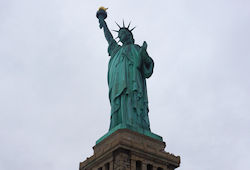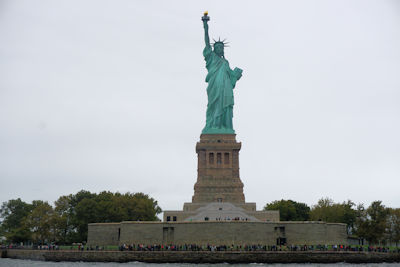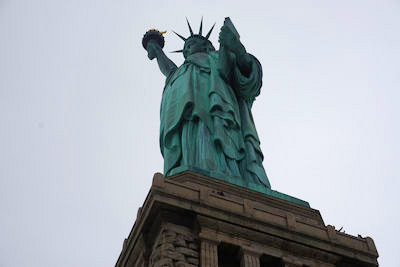
The Seven Wonders of the Ancient World were indeed awe-inspiring. From the Great Pyramid of Giza that dominated the Egyptian landscape to the 330-foot tall Lighthouse of Alexandria, the Statue of Zeus at Olympus to the Colossus of Rhodes that greeted visitors to the Greek island, each were engineering achievements equal to those of contemporary times.
French sculptor Auguste Bartholdi was fascinated by these wonders, as well as other marvels from the Ancient World, ever since he visited Egypt in 1856. Ten years afterwards, Bartholdi unveiled his plans for a new colossus that would rival those of old – a robed female figure bearing a torch, constructed at the entrance of the Suez Canal and named Progress: Egypt Carrying the Light to Asia. The project, however, was deemed too expensive, and a simpler lighthouse was constructed instead.
In 1865, Edouard de Laboulaye proposed building a monument in honor of the upcoming centennial of the United States that would also serve as a gift from France. While Auguste Bartholdi embraced the idea from an artistic standpoint, he also believed in the democratic principles upon which the United States was founded. Using his initial designs for the entrance of the Suez Canal as a starting point, Bartholdi added a crown and tablet, transforming his Statue of Progress into Liberty Enlightening the World, which was later shortened to simply the Statue of Liberty.
The personification of Liberty had evolved over millenniums by the time Auguste Bartholdi began crafting his version of Lady Liberty. The Roman Goddess of Liberty, for instance, was depicted over 2,000 years ago as wearing a Phrygian bonnet bestowed upon freed slaves and holding a scepter of sovereignty. During the first half of the nineteenth century, meanwhile, French artist Eugène Delacroix depicted Liberty as a revolutionary heroine brandishing a musket in his painting Liberty Leading the People.
The original name for the Statue of Liberty – Liberty Enlightening the World – outlined the overarching theme that Edouard de Laboulaye and Auguste Bartholdi wanted to convey with their creation. After not only the American Revolution but the French Revolution as well, the word “liberty” became synonymous with violence and revolt. The statue proposed by Laboulaye and Bartholdi wasn’t meant as a symbol of revolution, however, but a reflection of liberty as a form of enlightenment instead, and it was left to Auguste Bartholdi to create this new image for the ancient concept.
“The Statue of Liberty is a tapestry of old symbols woven together to create new meaning,” the Statue of Liberty exhibit on Liberty Island explains. “Her classical face and drapery suggest a Roman Goddess of Liberty; the broken shackles symbolize freedom newly achieved; the radiant crown represents her shedding light on the seven seas and continents. The tablet she holds – inscribed in Roman numerals ‘July 4, 1776’ – identifies the figure as an apostle of American freedom, law, and justice.”
In 1871, Auguste Bartholdi traveled to America to promote his statue, as well as find a suitable location for it to be displayed. Although feedback on the project was mixed, Bartholdi did find the perfect spot on a small island in New York Harbor called Bedloe’s Island. Other American cities had expressed interest in the statue, but Bartholdi believed New York was the true gateway to the United States and Bedloe’s was strategically located within its harbor. Fort Wood already occupied the island, but instead of an obstacle Bartholdi believed the fortress formed the ideal “base” on which to mount his statue.
The Colossus of Rhodes measured 108 feet in height. Auguste Bartholdi envisioned his Statue of Liberty extending 151 feet to the top of its torch. The usual sculpturing materials of stone, marble, and bronze were too heavy for such a creation, however, and it was decided to use hammered copper sheets laid on top of an iron frame instead, a process that the original Colossus of Rhodes may have likewise employed.
The Colossus of Rhodes also collapsed in 226 BC due to an earthquake. While Auguste Bartholdi was not worried about a similar fate awaiting his Statue of Liberty, he was concerned about the height and weight of the statue surviving the strong winds that blew across New York Harbor. Bartholdi thus enlisted famed engineer Gustave Eiffel – who would later construct a tower for the 1889 World’s Fair in Paris that bears his name – for assistance.
Eiffel designed both a primary and secondary internal framework for the Statue of Liberty, as well as a series of flat iron bars to connect the copper sheets to the secondary framework that likewise acted as springs and adjusted to changes in both temperature and wind pressure.
The completed Statue of Liberty was initially assembled in Paris before being shipped to America, and was officially presented as a gift to the United States on July 4, 1884. There was still one obstacle to overcome, however, before the statue could be raised on Liberty Island – the building of a pedestal for it to stand upon.
The decision had been made early on that the Statue of Liberty would be a joint effort of both the French and American people, with the funds to build the statue raised in France while payment for the pedestal would fall on the United States. Although innovative fundraising efforts resulted in the necessary funds for completion of the statue itself, American efforts to raise the $300,000 needed for construction of the pedestal fell short.
Just as the legendary Gustave Eiffel was instrumental in the design of the Statue of Liberty, another historical figure stepped in to help raise the remaining funds necessary for the pedestal – Joseph Pulitzer. As owner and publisher of the New York World newspaper, the Hungarian-born immigrant was a powerful and influential figure not only in New York but across the country. Using the front page of the World as promotion for a new fundraising drive, Pulitzer helped secure the remaining $100,000 necessary for completion of the pedestal in a mere five months.
The interconnecting pieces of the Statue of Liberty arrived in New York Harbor on June 19, 1885, and placed in storage until the pedestal was completed on Bedloe’s Island. Work began on its installation a year later, and the finalized Statue of Liberty was unveiled to the public on October 28, 1886.
As part of the pedestal fundraising effort, American poet Emma Lazarus composed a sonnet in 1883 entitled “The New Colossus.” Although published in the New York World at the time, the poem was largely forgotten afterwards. Lazarus died in 1887, and her friend Georgina Schuyler embarked on a mission to both memorialize Lazarus and “The New Colossus.” Schuler’s efforts paid off when a plaque bearing the text of the sonnet was placed within the pedestal of the Statue of Liberty in 1903.
Today, those words are just as famous as the statue itself, as well as synonymous with its overarching message – “Give me your tired, your poor, your huddled masses yearning to breathe free, the wretched refuse of your teeming shore. Send these, the homeless, tempest-tost to me, I lift my lamp beside the golden door!”
The Colossus of Rhodes was erected in 280 BC in celebration of Rhodes’ victory over Cyprus. The Lighthouse of Alexandria was completed in 317 BC to help guide ships into the port of Pharos, while the Great Pyramid of Giza was a homage to the Egyptian pharaoh Khufu and is even older, with construction being completed in 2560 BC.
Considered as three of the Seven Wonders of the Ancient World, each reflected their times as well as the beliefs of their populations. The Statue of Liberty in New York Harbor is a direct descendant of those engineering feats, and likewise representative of the concept of liberty that the United States personifies – making it a wonder of contemporary times in its own right.
Anthony Letizia





